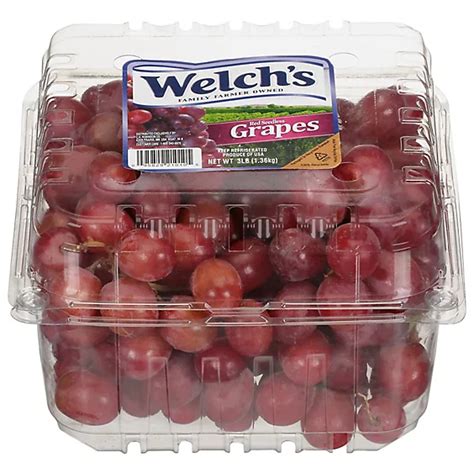What is Safeway Seedless Grapes?

Safeway is a grocery store chain that carries a variety of fresh produce, including seedless grapes. They offer both green and red seedless grapes in various sizes, ranging from 2 to 3 pounds. Safeway also carries organic seedless grapes under their O Organics brand.
Their Signature Farms brand also offers green seedless grapes that come in a 2-pound package. According to their website, this brand is made with 70% recycled drink bottles and can be scanned for more food information using the SmartLabel feature.
In terms of pricing , Safeway offers red and green seedless grapes at a regular price of $3.99 per pound, with occasional sales and promotions. In the past, they have offered red seedless grapes at a discounted price of $1.88 per pound.
Safeway's online shopping platform allows customers to order their seedless grapes and have them delivered straight to their doorstep or pick them up at their local store using their Drive Up & Go service.
Overall, Safeway offers a wide variety of seedless grapes to choose from, including organic options and environmentally conscious packaging. Their pricing is competitive, and their online shopping platform makes it easy for customers to purchase their desired items.
Frequently Asked Questions about safeway seedless grapes
They are grown from cuttings taken from an original root which had a seedless variety grafted on{that was produced by years of genetic manipulation}. Cuttings are in fact clones so are more reliable as a producer.
In the fall months, when most table grapes are done being harvested, they are put into storage and then shipped to American supermarkets as retailers order them. Usually in January, supermarkets begin importing table grapes from Chile.
When Did Seedless Grapes Become Popular? In the early 1870s, Scottish immigrant William Thompson began to import grape varieties to California from Iran and Turkey. Over time, he began to perfect the art of propagation and interbreeding on these varieties, eventually creating a seedless grape.
Although a rare mutant plant could be natural, the seedless form is not naturally occurring. The process of growing seedless grapes uses a form of asexual reproduction. The new plant is essentially a genetic clone of the original parent plant which requires manual manipulation with the plants genetic material.
Seedless grapes were originally a natural mutation that prevented the young seeds from maturing and developing a hard coat. And even seedless varieties do sometimes produce small numbers of seeds, which allows new varieties to be crossbred. Read more: How do seeds know which way to grow?
Seedless grapes are conventionally grown using pesticides and other chemicals to help prevent the development of seeds. Organic farming is becoming more popular for growers as it does not involve synthetic chemicals. Grapes certified as organic include seedless options, proving that organic grapes can also be seedless.
Grapes Today
Today, over 99 percent of grapes commercially grown in the United States come from California. With 90 varieties grown, California grapes come in three colors – green, red, and black – and are available May through January.
From these grapes, grape juice, wine, dealcoholized wine, and grape-based extract from grape seed, grape skin, whole grape, and grape pomace are produced.
He tries to jump and retrieve the grapes, but they are out of reach. Eventually, the fox determines that the grapes must be sour and confidently, yet disappointedly, walks away. The moral of the story is that you often hate what you can't have.
One might think that seedless fruits grow naturally, but that would be wrong. These fruits, also called “parthenocarpic” or “parthenogenetic,” cannot regenerate via producing seeds. This means that they must be propagated by cloning. Unfortunately, cloning is highly inefficient and leads to a loss of genetic diversity.
Seedless fruits involve no genetic engineering (they are not transgenic), only a very ancient practice consisting of embryonic selection or hybridisation.
Seedless grapes are also highly nutritious, containing phytonutrients, antioxidants, and vitamins. In a side-by-side comparison, red grapes have more nutrients than white grapes, offering higher amounts of Vitamin C, Vitamin K, flavonoids, and phytonutrients.
Common varieties of seedless fruits include watermelons, tomatoes, and grapes (such as Termarina rossa). Additionally, there are numerous seedless citrus fruits, such as oranges, lemons and limes. A recent development over the last twenty years has been that of seedless sweet peppers (Capsicum annuum).
Here are some of the most popular ones and their defining traits.
- Thompson seedless: green, fairly big, perfect for raisins.
- Flame seedless: red, round, crunchy.
- Concord: dark purple, round, bold grape flavor.
- Ruby seedless: deep red, oval, juicy.
- Moon Drop: almost black, long in length, crisp, sweet.
Grapes are commonly eaten as the whole fruit, and in juices, jellies, and other products. As medicine, whole grape extracts, grape seed extracts, grape leaf or vine extracts, grape juices, and grape pomaces have been used. Grape seed and grape vine extracts are also used in creams, ointments, and sprays.
A grape is a fruit, botanically a berry, of genus Vitis and family Vitaceae. Grapes grow in clusters of 15–300 in different colors (crimson, black, dark blue, yellow, green, orange, pink, and white) and are specifically a nonclimacteric type and deciduous crop.
















